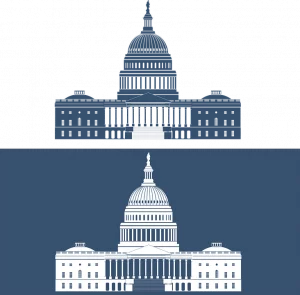On January 19, 2022, two Senate Democrats joined 50 Republican colleagues in voting down proposed rule changes to the hotly contested filibuster. The 48-52 vote fell short of the 50 votes necessary to change the rule, which aimed to reinstate the «talking filibuster».
Though the filibuster, a means to extend debate and prevent a vote on matters before a legislative body, has no mention in the United States Constitution, its origins can be traced back to the country’s foundational document. Article I, Section 5 of the Constitution states that «each House may determine the rules of its proceedings.» This language grants both chambers of Congress, the House of Representatives and U.S. Senate, to establish its own procedural rules.
The original rules of the Senate allowed a simple majority of legislators to make a motion to end debate and vote on a matter. This changed in 1805, when Vice President Aaron Burr, citing the need for robust and deliberate debate on all matters before the lawmakers, convinced the Senate to eliminate this rule. The following year the rules were amended and unlimited debate was now allowed within the Senate. Unlimited debate, though rarely used as a legislative tactic, remained available until the presidency of Woodrow Wilson. During the contentious period of World War 1, public pressure grew and the Senate amended its rules to allow an end to debate by a two-thirds vote of present Senators. This supermajority vote to end Senate debate is known as «cloture».
It wasn’t until the 1960’s, during the debate over the Civil Rights Act, that efforts to amend the filibuster were once again attempted. One such rule borne from this era was the lowering of the supermajority necessary for cloture. The Senate revised the two-thirds vote threshold to what it stands at today, three-fifths (or 60 votes). The second rule change, and more controversial of the two, was the implementation of the silent filibuster. Unlike a talking filibuster, which saw a member of the Senate stall a vote by talking for hours on the Senate floor, the silent filibuster allows a member to block a vote from happening through simply remarking their intention to filibuster and that they have enough votes to support their filibuster. With the silent filibuster rule, a Senator is not required to speak in public to prevent the passage of a bill, and can simply send an email declaring their intention to filibuster.
In more recent history, the Senate in 2013 and 2017 made significant changes to its procedural rules around the filibuster. In both cases the Senate invoked the nuclear option, a procedure that allows the majority party to change a Senate rule with a simple majority vote. In 2013, Senate Majority Leader, Democrat Harry Reid used the option to alter the voting requirements for executive nominee confirmations. Four years later, Republican Senate Majority Leader Mitch McConnell invoked the nuclear option, changing the 60-vote threshold for ending debate on Supreme Court nominees to a simple majority. The passage of certain types of legislation, including the proposed Voting Rights Act, are one of the last few legislative activities in which a filibuster can not be ended by a simple majority cloture vote. Seemingly, the debate over the filibuster and its role in today’s modern Senate will continue for the foreseeable future.
This week’s Current Events resources examine the filibuster. The resources shared provide background and context on the history of the filibuster and cloture, as well as the debate around its role in a democratic society.
Looking for more current events resources? Sign up at our We the Teachers Educator Resource Community page, where you can find all of our Current Events, and learn about our other programs!
Essential Questions, Vocabulary & Extend the Resources:
- What is the filibuster?
- Where is the filibuster codified as a rule within the federal government?
- What are the goals and objectives of the filibuster rule?
- What are the main objections opponents to the filibuster cite as to why the filibuster should be eliminated or reformed?
- How has the history of the Senate impacted the filibuster?
- In your opinion, has the modern day use of the filibuster aligned with its original intentions? Explain
- In your opinion, is the filibuster a democracy-saving tool or an anti-democratic component to the function of the Senate?
Click here for a hardcopy of the Essential Questions & Filibuster Vocabulary
Click here for a hardcopy of the Extend the Resources handout with suggested lesson activities and extensions
Videos:
Podcasts:
The case for ending the filibuster, Today, Explained, October 13, 2020
Why We Must Save the Filibuster, Heritage Explains, December 15, 2021
The Filibuster, Civics 101
The Filibuster: An Obstruction or Preservation of Democracy?, The Takeaway, NPR, January 18, 2022
Background Resources:
About Filibusters and Cloture, United States Senate
The Filibuster, Explained, Brennan Center for Justice
The Filibuster, Stanford Law Review
Recent Articles:
Senate Democrats plan a vote to change the filibuster. So what is it?, NPR, January 17, 2022
Filibuster: What to know about the political delay tactic, Fox News, January 21, 2022
Democrats fail to advance voting rights law as Senate holdouts defend filibuster, The Guardian, January 20, 2022
Voting rights bill blocked by Republican filibuster, PBS News Hour, January 19, 2022
‘Jim Crow relic’: A short history of the filibuster, The Boston Globe, January 15, 2022
Recent Editorials:
Five myths about the filibuster, The Washington Post, January 7, 2022
‘All or nothing’ won’t bolster American democracy: Reform the filibuster and Electoral Count Act, The Hill, January 18, 2022
What Mitt Romney Doesn’t Understand About the End of the Filibuster, The New York Times, January 19, 2022
Remind me, why do we need the filibuster?, Los Angeles Times, August 6, 2021
Images & Infographics:


Lesson Plans:
Bell Ringer: The Filibuster and Deliberation in the Senate, C-SPAN Classroom
Bell Ringer: The History of the Filibuster in the Senate, C-SPAN Classroom
The Senate Filibuster & Democracy, Morningside Center for Teaching Social Responsibility
Mini-lesson: Filibusters (HS), iCivics
Should the legislative filibuster rule be eliminated in the Senate?, AFT & C-SPAN Classroom
The Filibuster, The Bill of Rights Institute
Media & News Literacy Lesson Plans:
Media Literacy Resources – Newseum
News & Media Literacy Lessons – Common Sense
Media Misinformation, Viral Deception, and «Fake News» – University of Wyoming
Evaluating Sources in a ‘Post-Truth’ World: Ideas for Teaching and Learning About Fake News – New York Times Lessons





